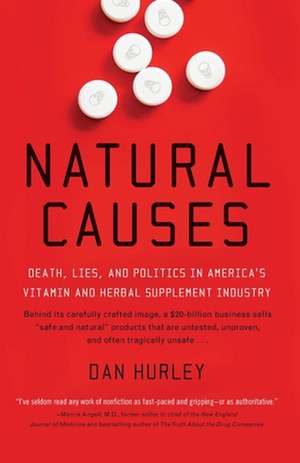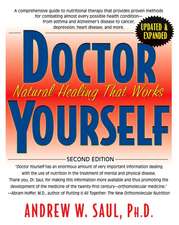Natural Causes: Death, Lies and Politics in America's Vitamin and Herbal Supplement Industry
Autor Dan Hurleyen Limba Engleză Paperback – 30 noi 2007
Over 60 percent of Americans buy and take herbal and dietary supplements for all sorts of reasons—to prevent illness (vitamin C), to ease depression (St. John’s wort), to aid weight loss (ephedra), to boost the memory (ginkgo biloba), and even to cure cancer (shark cartilage, bloodroot)—despite the fact that few of these “natural” supplements have been proven to be safe or effective. The vitamin and herbal supplement industry generates over $20 billion a year by selling products that promise to cure or fix, but are produced and marketed essentially without oversight. And while the media has been quick to sensationalize the benefits of supplements, few have taken a hard look at the dangers posed by many of the remedies flooding the market today. Award-winning journalist Dan Hurley breaks the silence for the first time in Natural Causes.
From the snake-oil salesmen of the early twentieth century, to rise of the health food movement in the sixties and seventies, Hurley charts the remarkable growth of an industry built largely on fraud, and reveals the backroom politics that led to the passage of the Dietary Supplement Health and Education Act of 1994, which effectively freed the industry from FDA oversight. In unprecedented detail, he shows how supplement manufacturers have concealed the truth about dozens of untested treatments and the shocking rise in deaths, disfigurements, and life-threatening injuries caused by products deceptively promoted as “safe and natural.” Most importantly, he provides a telling look at why, in an age of unprecedented scientific advancement, we continue to buy and believe in remedies for which little evidence exists—and why the supplements we take to promote our health may be doing far more harm than good.
As Hurley shows, the dietary supplement craze may be one of the greatest swindles ever perpetrated on the American public—one that feeds billions of dollars each year into the pockets of lobbyists, politicians, and any charlatan who wants to slap a label on a bottle and tout it as the next big “natural cure.” Blending hard facts with spellbinding personal stories, Natural Causes is a must-read for anyone who has ever popped a multivitamin or an herb, and provides a hard-hitting, frightening look at a cultural trend that is out of control.
Preț: 115.73 lei
Nou
Puncte Express: 174
Preț estimativ în valută:
22.14€ • 23.12$ • 18.33£
22.14€ • 23.12$ • 18.33£
Carte disponibilă
Livrare economică 14-28 martie
Preluare comenzi: 021 569.72.76
Specificații
ISBN-13: 9780767920438
ISBN-10: 0767920430
Pagini: 336
Dimensiuni: 140 x 216 x 19 mm
Greutate: 0.43 kg
Editura: BROADWAY BOOKS
ISBN-10: 0767920430
Pagini: 336
Dimensiuni: 140 x 216 x 19 mm
Greutate: 0.43 kg
Editura: BROADWAY BOOKS
Notă biografică
dan hurley is an award-winning journalist specializing in health and medical writing, and a regular contributor to the New York Times. His work has also appeared in the Houston Chronicle, Men’s Health, Psychology Today, and many other publications. He lives with his wife and daughter in New Jersey.
Extras
CHAPTER 1
THE RATTLESNAKE KING
There really was a snake oil. A hundred years ago, during the great patent medicine era, American consumers could buy Tex Bailey's Rattle Snake Oil (made not in Texas but in Troy, N.Y.); Tex Allen's Rattlesnake Essential Oil Compound, recommended for “rheumatic pains, back pain, strains, sprains, bruises, sores, aching feet, stiff joints, sore muscles, throat irritation, headache, earache, and more” (manufactured in Newark, N.J.); Rattlesnake Bill's Liniment, “made from the fat of a real diamondback rattlesnake” (manufactured in exotic Belleville, N.J.); the Great Yaquis Snake-Oil Liniment; Blackhawks Indian Liniment Oil; Monster Brand Snake Oil; and Mack Mahon the Rattle Snake Oil King's Liniment for Rheumatism and Catarrh.
Far from having the negative connotation we give it today, snake oil in those days was sold on the basis of Americans’ infatuation with cowboys, the Old West, and Indians. No one better exploited that fascination than Clark Stanley, another self-crowned “Rattle Snake King.” In a fifty-page booklet he published in 1897, Stanley gave the first twenty–five pages over to the colorful life of cowboys before devoting the remaining pages to the wonders of snake oil. With handlebar mustache, goatee, broad–brimmed hat, boots, kerchief, and jeans, he certainly looked the part of a cowboy. The story he told of his life was a compelling one: Born in Abilene, Texas, around the time of the Civil War, he lived the life of a cowboy from the age of fourteen to twenty–five. Then, in the spring of 1879, he followed some of his father's friends to Walpi, Arizona, to see the snake dance of the Moki (now known as the Hopi) Indians.
“There I became acquainted with the medicine man of the Moki tribe,” Stanley wrote in his booklet, “and as he liked the looks of my Colt’s revolver and asked me to show him how it would shoot, I gave him an exhibition of my fancy shooting, which pleased him very much; he then asked me how I would like to stay there and live with him, I told him I would stay until the snake dance.” After witnessing the dance, his father's friends left, but Stanley decided to stay on, and he lived with the Moki for two years and five months.
“I learned their language and dances and the secret of making their medicines,” he wrote. “The medicine that interested me most was their Snake Oil Medicine as they called it. It is used for rheumatism, contracted cords and all aches and pains. As I was thought a great deal of by the medicine man, he gave me the secret of making the Snake Oil Medicine, which is now named Clark Stanley's Snake Oil Liniment. Snake Oil is not a new discovery, it has been in use by the Mokis and other Indian tribes for many generations, and I have made an improvement on the original formula.”
There are no independent historic documents attesting to how much, if any, of Stanley’s story is true. But he certainly seemed to know a great deal about the cowboy life, and it is accurate that the Hopi Indians held snake dances in Walpi, Arizona; President Teddy Roosevelt would attend one in the summer of 1913. But in any case, Stanley's story continued with the turning point that stories such as these almost always have: he tried it on some friends and neighbors back home, and it was such a great cure that soon he was manufacturing it and selling it with great success. By his account, Stanley traveled the West and Southwest for some ten years, selling his snake oil “with unbounded success.”
Then came the 1893 World's Columbian Exhibition in Chicago—the largest public event in the history of the United States to date, where President Grover Cleveland threw an electric switch to open it, the Ferris wheel made its international debut, and more than 25 million people attended during its six–month course. Here, dressed in his colorful cowboy outfit, Stanley made a show of handling snakes.
In the only surviving interview of Stanley conducted by an independent source, he described his routine this way: “The audience see [sic] me kill the snakes, draw out the oil and put it into a glass dish. Then I walk down among them and show it to them. Then, I go back and here is a big glass jar, like you make orangeade in. First, I put the snake oil in, and then I put nine other oils in which have previously been mixed in a can, so that they don't see all of what my formula is. I pour that in on top of the snake oil, turn the mixture around, and if it doesn’t mix thoroughly, looks a little cloudy, I stir it again. Then I let it set for just a moment, and it becomes clear.”
Then he would sell the freshly prepared snake oil liniment, along with many other bottles previously made. As the months passed, he met druggists from across the United States, including one from Boston who persuaded him to move there and open a manufacturing plant.
So it was that, according to a copy of a Boston Transcript article reprinted in Stanley’s booklet, a reporter found him at his office at 67 Park Street in nearby Beverly with a house full of snakes. “The snake man took the reporter up to his bedroom, and opening a light wooden box, with a wire window in the side, dove his hand into it with as much unconcern as if he were taking an egg out of a basket, and brought it out again with a snake seven feet long writhing in it.” Eventually he pulled out two more large venomous snakes and allowed them to twine themselves around his body, their forked black tongues flicking in and out against his skin.
“The bite of any one of these snakes is absolutely deadly,” Stanley told the reporter. “No, I am not the least afraid of being bitten. In fact, I have been bitten hundreds of times. Look here!” He showed his hands, which were covered to the wrists in tiny white scars. Not all were from poisonous snakes, he said, but he continued, “I have also been bitten by snakes which had their glands full of poison, and meant business. The reason I am not dead is because I have what I believe is the only remedy for snake-bite, and there is no question that it is a perfect one.”
While it is possible that Stanley gradually built up a limited immunity to venomous snake bites, as other snake handlers have done, there was not any effective “remedy” for such bites in those days. Today, the only treatment is antivenom, made by injecting small amounts of venom into an animal and then harvesting the immune cells that the animal's blood generates.
By 1901, Stanley had moved to a bigger manufacturing plant in Providence, Rhode Island, where he claimed to have killed three thousand snakes for his snake oil the previous year, as well as two thousand more at his “snake farm” in Texas. "In covered pens may be seen thousands of snakes fattened ready to be killed for their oil,” a reporter wrote. “Clark Stanley says that the world is just beginning to realize the actual value of snake oil and that there are hundreds of uses to which it might be applied that are not yet recognized.”
His labeling, as well as the accompanying booklet, attempted to scratch the surface of those hundreds of uses: “For Rheumatism, Neuralgia, Sciatica, Lame Back, Contracted Muscles, Sprains, Swellings, Frost Bites, Chilblains, Bruises, Sore Throat, Bites of Animals, Insects and Reptiles. Good for Man and Beast. A Liniment that penetrates Muscle, Membrane and Tissue to the very bone itself, and banishing pain with a power that has astonished the Medical Profession.” Two figures illustrated the “best method for curing Partial Paralysis of the Arms.” Another figure illustrated “the way to bathe the head for Neuralgia, Headache, Tic Douloureux.” For the bites of animals, insects, or reptiles, Clark Stanley’s Snake Oil Liniment was to “be applied as soon as possible. It kills the poison, relieves the pain, reduces the swelling and heals the wound.”
On the day Columbus first set foot in the New World at San Salvador in 1492, he wrote in his journal, “The natives brought fruit, wooden spears, and certain dried leaves which gave off a distinct fragrance.” The dried leaves, it turned out, were tobacco, the first pharmacologically active herb (due to its nicotine content) brought back to Europe—not that tobacco would ever be regulated as a drug, despite being an addictive stimulant.
“When we discovered the New World, the Old World was looking for cures for diseases,” says Michael R. Harris, who served as the historian of pharmacy at the Smithsonian Institution for twenty-six years before becoming the historian and curator at the Drug Enforcement Administration Museum. He also consulted as a historian to the television show Dr. Quinn, Medicine Woman. Beyond cures, Harris says, people wanted stimulants. That’s why when tobacco, coffee, and tea all hit world markets in the sixteenth century, “they became instant hits worldwide. No drugs, except later for the amphetamines, have spread around the world so quickly.”
In 1632, Catholic Jesuits who had gone to Peru brought back a powder from the cinchona tree, which natives used to bring down the fevers of malaria. In Europe, no effective treatment had been known for malaria, and physicians were soon calling the “Jesuit bark” as important a development in medicine as gunpowder was to warfare. The powder, French scientists would determine nearly two centuries later, contained quinine. When it cured the malarial fevers of King Charles II of England, it confirmed the view that great medicines could be found in the forests of the New World.
Indeed, today it is estimated that more than one fourth of modern medicines are derived from botanicals, including aspirin, from willow bark, and the cancer-fighting compound paclitaxel (Taxol), from the Pacific yew tree. Digitalis likewise is derived from foxglove, but the plant was originally used for everything from treating wounds to, as one herbalist put it, curing a “scabby head,” and had developed a reputation by the eighteenth century for being poisonous. Then, in 1775, the Scottish physician William Withering was asked his opinion of a folk remedy for “dropsy,” what is now known as congestive heart failure, a condition for which mainstream medicine then had no cure. Dr. Withering described the remedy in his 1785 book, Account of the Foxglove and Some of Its Medical Uses: “I was told that it had long been kept a secret by an old woman in Shropshire, who had sometimes made cures after the more regular practitioners had failed. I was informed also, that the effects produced were violent vomiting and purging… This medicine was composed of twenty or more different herbs; but it was not very difficult for one conversant in these subjects, to perceive, that the active herb could be no other than the Foxglove.”
As a medical student, Dr. Withering had hated his classes on the identification and preparation of herbs, thinking them dreadfully boring. But he developed a passion for them after meeting the beautiful Helena Cooke, who just happened to be an amateur painter of botanical specimens; they married in 1772. After witnessing a patient's remarkable recovery from dropsy after taking the old woman's remedy, Dr. Withering proceeded to test different formulations of foxglove extract on 158 patients, settling on a green powder made from the dried flowers harvested just before blossoming. Although only 101 of his patients experienced relief after receiving the foxglove treatment, Dr. Withering described all 158 cases in detail. As he wrote: “It would have been an easy task to have given select cases, whose successful treatment would have spoken strongly in favour of the medicine, and perhaps been flattering to my own reputation. But Truth and Science would condemn the procedure. I have therefore mentioned every case…proper or improper, successful or otherwise.” Even then, he emphasized the provisional nature of his observations, insisted that doctors use care in selecting which patients to treat with it, and gave instructions on how to titrate the dosage. The synthetic versions, digitoxin and digoxin, remain widely used to treat heart failure to this day.
With the New World’s medicines, however, came the snake oil. In 1630, Nicholas Knapp of Massachusetts Bay was sentenced to pay five pounds, or be whipped, for selling a would-be cure for scurvy that turned out to be nothing more than “a water of no worth nor value,” which he “solde att a very deare rate.” But it was often difficult to tell mainstream doctors from the quacks. Ben Franklin’s own mother–in–law developed a salve for lice and itching called Widow Read's Ointment, which Franklin advertised before the Revolution in his Pennsylvania Gazette. And George Washington himself died in 1799 after a throat infection led his doctors to bleed him—a practice dating back to Hippocrates in the fifth century B.C.—reportedly draining about half of the seven liters of blood in his body in twenty-four hours, which, in the view of some doctors, may be what actually caused his death. Even in the nineteenth century, while the emerging science of chemistry gave medical doctors an aura of respectability, precious little of value made its way from the laboratory to the bedside. The most eminent physician of the early 1800s, Benjamin Rush of Philadelphia, developed a theory that the cause of fevers and most other illnesses was “excitability” of the blood vessels, or high blood pressure. He lowered the pressure by bleeding patients, removing up to 80 percent of their blood, and purging their bowels. His purgative of choice was calomel, or mercury chloride, a tasteless mineral so powerful that patients sometimes ended up losing their teeth and jawbones. Even a useful remedy like quinine was turned into an all–purpose “tonic” and used for just about anything. The other two popular tonics of the nineteenth century were iron and—in small amounts—strychnine, derived from the nux vomica plant, and better known these days as a poison.
With “cures” like these, it isn’t surprising that other theories no odder than those of mainstream medicine's would arise and find support. One came from a German chemist, Dr. Samuel Hahnemann, who in 1796 developed his hair–of–the–dog–that–bit–me theory. “Let likes be treated with likes,” he said, proposing that a substance causing certain unpleasant symptoms in a healthy person could, if given in minuscule amounts, cure a person who was suffering those very same symptoms due to an illness. He called his method homeopathy, from the Greek homoios (similar) and pathos (suffering or disease). Another of his counterintuitive beliefs was that the less of a substance he gave to patients, the more powerful it became. In fact, he claimed, the substances worked best when diluted until no discernible trace remained. A spiritlike essence, he believed, was left behind that would revive the body's vital force. Although not supported by modern science, homeopathy did have one great thing going for it: it didn't injure patients like bloodletting and calomel did. Many doctors began using homeopathic treatments, and eventually many schools of homeopathy were opened in the United States.
Another challenger to what passed for mainstream medicine was an unschooled frontier farmer, Samuel Thomson, who attacked the doctors’ harsh medicines and championed the healing qualities of simple herbs, particularly lobelia (its prime effect implied by its folk name, pukeweed). His theory was that all illness was caused by “cold,” and that the cure was “heat,” which he achieved with steam baths, sweat–inducing herbs like red pepper, and other herbs that would cause people to vomit or move their bowels in an attempt to remove “obstructions” to the body's natural heat balance. Doctors derided his simple theories and overemphasis on lobelia, and he was jailed on murder charges after one of his patients died. But Thomson succeeded in setting off a historic cultural swing away from “scientific” medicine overseen by experts who emphasized chemically derived medicines to “natural” medicine overseen by individuals using herbs on themselves.
From the Hardcover edition.
THE RATTLESNAKE KING
There really was a snake oil. A hundred years ago, during the great patent medicine era, American consumers could buy Tex Bailey's Rattle Snake Oil (made not in Texas but in Troy, N.Y.); Tex Allen's Rattlesnake Essential Oil Compound, recommended for “rheumatic pains, back pain, strains, sprains, bruises, sores, aching feet, stiff joints, sore muscles, throat irritation, headache, earache, and more” (manufactured in Newark, N.J.); Rattlesnake Bill's Liniment, “made from the fat of a real diamondback rattlesnake” (manufactured in exotic Belleville, N.J.); the Great Yaquis Snake-Oil Liniment; Blackhawks Indian Liniment Oil; Monster Brand Snake Oil; and Mack Mahon the Rattle Snake Oil King's Liniment for Rheumatism and Catarrh.
Far from having the negative connotation we give it today, snake oil in those days was sold on the basis of Americans’ infatuation with cowboys, the Old West, and Indians. No one better exploited that fascination than Clark Stanley, another self-crowned “Rattle Snake King.” In a fifty-page booklet he published in 1897, Stanley gave the first twenty–five pages over to the colorful life of cowboys before devoting the remaining pages to the wonders of snake oil. With handlebar mustache, goatee, broad–brimmed hat, boots, kerchief, and jeans, he certainly looked the part of a cowboy. The story he told of his life was a compelling one: Born in Abilene, Texas, around the time of the Civil War, he lived the life of a cowboy from the age of fourteen to twenty–five. Then, in the spring of 1879, he followed some of his father's friends to Walpi, Arizona, to see the snake dance of the Moki (now known as the Hopi) Indians.
“There I became acquainted with the medicine man of the Moki tribe,” Stanley wrote in his booklet, “and as he liked the looks of my Colt’s revolver and asked me to show him how it would shoot, I gave him an exhibition of my fancy shooting, which pleased him very much; he then asked me how I would like to stay there and live with him, I told him I would stay until the snake dance.” After witnessing the dance, his father's friends left, but Stanley decided to stay on, and he lived with the Moki for two years and five months.
“I learned their language and dances and the secret of making their medicines,” he wrote. “The medicine that interested me most was their Snake Oil Medicine as they called it. It is used for rheumatism, contracted cords and all aches and pains. As I was thought a great deal of by the medicine man, he gave me the secret of making the Snake Oil Medicine, which is now named Clark Stanley's Snake Oil Liniment. Snake Oil is not a new discovery, it has been in use by the Mokis and other Indian tribes for many generations, and I have made an improvement on the original formula.”
There are no independent historic documents attesting to how much, if any, of Stanley’s story is true. But he certainly seemed to know a great deal about the cowboy life, and it is accurate that the Hopi Indians held snake dances in Walpi, Arizona; President Teddy Roosevelt would attend one in the summer of 1913. But in any case, Stanley's story continued with the turning point that stories such as these almost always have: he tried it on some friends and neighbors back home, and it was such a great cure that soon he was manufacturing it and selling it with great success. By his account, Stanley traveled the West and Southwest for some ten years, selling his snake oil “with unbounded success.”
Then came the 1893 World's Columbian Exhibition in Chicago—the largest public event in the history of the United States to date, where President Grover Cleveland threw an electric switch to open it, the Ferris wheel made its international debut, and more than 25 million people attended during its six–month course. Here, dressed in his colorful cowboy outfit, Stanley made a show of handling snakes.
In the only surviving interview of Stanley conducted by an independent source, he described his routine this way: “The audience see [sic] me kill the snakes, draw out the oil and put it into a glass dish. Then I walk down among them and show it to them. Then, I go back and here is a big glass jar, like you make orangeade in. First, I put the snake oil in, and then I put nine other oils in which have previously been mixed in a can, so that they don't see all of what my formula is. I pour that in on top of the snake oil, turn the mixture around, and if it doesn’t mix thoroughly, looks a little cloudy, I stir it again. Then I let it set for just a moment, and it becomes clear.”
Then he would sell the freshly prepared snake oil liniment, along with many other bottles previously made. As the months passed, he met druggists from across the United States, including one from Boston who persuaded him to move there and open a manufacturing plant.
So it was that, according to a copy of a Boston Transcript article reprinted in Stanley’s booklet, a reporter found him at his office at 67 Park Street in nearby Beverly with a house full of snakes. “The snake man took the reporter up to his bedroom, and opening a light wooden box, with a wire window in the side, dove his hand into it with as much unconcern as if he were taking an egg out of a basket, and brought it out again with a snake seven feet long writhing in it.” Eventually he pulled out two more large venomous snakes and allowed them to twine themselves around his body, their forked black tongues flicking in and out against his skin.
“The bite of any one of these snakes is absolutely deadly,” Stanley told the reporter. “No, I am not the least afraid of being bitten. In fact, I have been bitten hundreds of times. Look here!” He showed his hands, which were covered to the wrists in tiny white scars. Not all were from poisonous snakes, he said, but he continued, “I have also been bitten by snakes which had their glands full of poison, and meant business. The reason I am not dead is because I have what I believe is the only remedy for snake-bite, and there is no question that it is a perfect one.”
While it is possible that Stanley gradually built up a limited immunity to venomous snake bites, as other snake handlers have done, there was not any effective “remedy” for such bites in those days. Today, the only treatment is antivenom, made by injecting small amounts of venom into an animal and then harvesting the immune cells that the animal's blood generates.
By 1901, Stanley had moved to a bigger manufacturing plant in Providence, Rhode Island, where he claimed to have killed three thousand snakes for his snake oil the previous year, as well as two thousand more at his “snake farm” in Texas. "In covered pens may be seen thousands of snakes fattened ready to be killed for their oil,” a reporter wrote. “Clark Stanley says that the world is just beginning to realize the actual value of snake oil and that there are hundreds of uses to which it might be applied that are not yet recognized.”
His labeling, as well as the accompanying booklet, attempted to scratch the surface of those hundreds of uses: “For Rheumatism, Neuralgia, Sciatica, Lame Back, Contracted Muscles, Sprains, Swellings, Frost Bites, Chilblains, Bruises, Sore Throat, Bites of Animals, Insects and Reptiles. Good for Man and Beast. A Liniment that penetrates Muscle, Membrane and Tissue to the very bone itself, and banishing pain with a power that has astonished the Medical Profession.” Two figures illustrated the “best method for curing Partial Paralysis of the Arms.” Another figure illustrated “the way to bathe the head for Neuralgia, Headache, Tic Douloureux.” For the bites of animals, insects, or reptiles, Clark Stanley’s Snake Oil Liniment was to “be applied as soon as possible. It kills the poison, relieves the pain, reduces the swelling and heals the wound.”
On the day Columbus first set foot in the New World at San Salvador in 1492, he wrote in his journal, “The natives brought fruit, wooden spears, and certain dried leaves which gave off a distinct fragrance.” The dried leaves, it turned out, were tobacco, the first pharmacologically active herb (due to its nicotine content) brought back to Europe—not that tobacco would ever be regulated as a drug, despite being an addictive stimulant.
“When we discovered the New World, the Old World was looking for cures for diseases,” says Michael R. Harris, who served as the historian of pharmacy at the Smithsonian Institution for twenty-six years before becoming the historian and curator at the Drug Enforcement Administration Museum. He also consulted as a historian to the television show Dr. Quinn, Medicine Woman. Beyond cures, Harris says, people wanted stimulants. That’s why when tobacco, coffee, and tea all hit world markets in the sixteenth century, “they became instant hits worldwide. No drugs, except later for the amphetamines, have spread around the world so quickly.”
In 1632, Catholic Jesuits who had gone to Peru brought back a powder from the cinchona tree, which natives used to bring down the fevers of malaria. In Europe, no effective treatment had been known for malaria, and physicians were soon calling the “Jesuit bark” as important a development in medicine as gunpowder was to warfare. The powder, French scientists would determine nearly two centuries later, contained quinine. When it cured the malarial fevers of King Charles II of England, it confirmed the view that great medicines could be found in the forests of the New World.
Indeed, today it is estimated that more than one fourth of modern medicines are derived from botanicals, including aspirin, from willow bark, and the cancer-fighting compound paclitaxel (Taxol), from the Pacific yew tree. Digitalis likewise is derived from foxglove, but the plant was originally used for everything from treating wounds to, as one herbalist put it, curing a “scabby head,” and had developed a reputation by the eighteenth century for being poisonous. Then, in 1775, the Scottish physician William Withering was asked his opinion of a folk remedy for “dropsy,” what is now known as congestive heart failure, a condition for which mainstream medicine then had no cure. Dr. Withering described the remedy in his 1785 book, Account of the Foxglove and Some of Its Medical Uses: “I was told that it had long been kept a secret by an old woman in Shropshire, who had sometimes made cures after the more regular practitioners had failed. I was informed also, that the effects produced were violent vomiting and purging… This medicine was composed of twenty or more different herbs; but it was not very difficult for one conversant in these subjects, to perceive, that the active herb could be no other than the Foxglove.”
As a medical student, Dr. Withering had hated his classes on the identification and preparation of herbs, thinking them dreadfully boring. But he developed a passion for them after meeting the beautiful Helena Cooke, who just happened to be an amateur painter of botanical specimens; they married in 1772. After witnessing a patient's remarkable recovery from dropsy after taking the old woman's remedy, Dr. Withering proceeded to test different formulations of foxglove extract on 158 patients, settling on a green powder made from the dried flowers harvested just before blossoming. Although only 101 of his patients experienced relief after receiving the foxglove treatment, Dr. Withering described all 158 cases in detail. As he wrote: “It would have been an easy task to have given select cases, whose successful treatment would have spoken strongly in favour of the medicine, and perhaps been flattering to my own reputation. But Truth and Science would condemn the procedure. I have therefore mentioned every case…proper or improper, successful or otherwise.” Even then, he emphasized the provisional nature of his observations, insisted that doctors use care in selecting which patients to treat with it, and gave instructions on how to titrate the dosage. The synthetic versions, digitoxin and digoxin, remain widely used to treat heart failure to this day.
With the New World’s medicines, however, came the snake oil. In 1630, Nicholas Knapp of Massachusetts Bay was sentenced to pay five pounds, or be whipped, for selling a would-be cure for scurvy that turned out to be nothing more than “a water of no worth nor value,” which he “solde att a very deare rate.” But it was often difficult to tell mainstream doctors from the quacks. Ben Franklin’s own mother–in–law developed a salve for lice and itching called Widow Read's Ointment, which Franklin advertised before the Revolution in his Pennsylvania Gazette. And George Washington himself died in 1799 after a throat infection led his doctors to bleed him—a practice dating back to Hippocrates in the fifth century B.C.—reportedly draining about half of the seven liters of blood in his body in twenty-four hours, which, in the view of some doctors, may be what actually caused his death. Even in the nineteenth century, while the emerging science of chemistry gave medical doctors an aura of respectability, precious little of value made its way from the laboratory to the bedside. The most eminent physician of the early 1800s, Benjamin Rush of Philadelphia, developed a theory that the cause of fevers and most other illnesses was “excitability” of the blood vessels, or high blood pressure. He lowered the pressure by bleeding patients, removing up to 80 percent of their blood, and purging their bowels. His purgative of choice was calomel, or mercury chloride, a tasteless mineral so powerful that patients sometimes ended up losing their teeth and jawbones. Even a useful remedy like quinine was turned into an all–purpose “tonic” and used for just about anything. The other two popular tonics of the nineteenth century were iron and—in small amounts—strychnine, derived from the nux vomica plant, and better known these days as a poison.
With “cures” like these, it isn’t surprising that other theories no odder than those of mainstream medicine's would arise and find support. One came from a German chemist, Dr. Samuel Hahnemann, who in 1796 developed his hair–of–the–dog–that–bit–me theory. “Let likes be treated with likes,” he said, proposing that a substance causing certain unpleasant symptoms in a healthy person could, if given in minuscule amounts, cure a person who was suffering those very same symptoms due to an illness. He called his method homeopathy, from the Greek homoios (similar) and pathos (suffering or disease). Another of his counterintuitive beliefs was that the less of a substance he gave to patients, the more powerful it became. In fact, he claimed, the substances worked best when diluted until no discernible trace remained. A spiritlike essence, he believed, was left behind that would revive the body's vital force. Although not supported by modern science, homeopathy did have one great thing going for it: it didn't injure patients like bloodletting and calomel did. Many doctors began using homeopathic treatments, and eventually many schools of homeopathy were opened in the United States.
Another challenger to what passed for mainstream medicine was an unschooled frontier farmer, Samuel Thomson, who attacked the doctors’ harsh medicines and championed the healing qualities of simple herbs, particularly lobelia (its prime effect implied by its folk name, pukeweed). His theory was that all illness was caused by “cold,” and that the cure was “heat,” which he achieved with steam baths, sweat–inducing herbs like red pepper, and other herbs that would cause people to vomit or move their bowels in an attempt to remove “obstructions” to the body's natural heat balance. Doctors derided his simple theories and overemphasis on lobelia, and he was jailed on murder charges after one of his patients died. But Thomson succeeded in setting off a historic cultural swing away from “scientific” medicine overseen by experts who emphasized chemically derived medicines to “natural” medicine overseen by individuals using herbs on themselves.
From the Hardcover edition.
Recenzii
“A well-written and detailed expose. . . A strident wake-up call.”— Business Week
“Highly readable . . . [Hurley’s] crisp narrative will shock many Americans.” — St. Louis Post-Dispatch
“An engrossing book [and] a much-needed corrective to the promotion of so-called natural treatments . . . [Natural Causes] deserves a wide audience.” —New England Journal of Medicine
“Highly readable . . . [Hurley’s] crisp narrative will shock many Americans.” — St. Louis Post-Dispatch
“An engrossing book [and] a much-needed corrective to the promotion of so-called natural treatments . . . [Natural Causes] deserves a wide audience.” —New England Journal of Medicine














